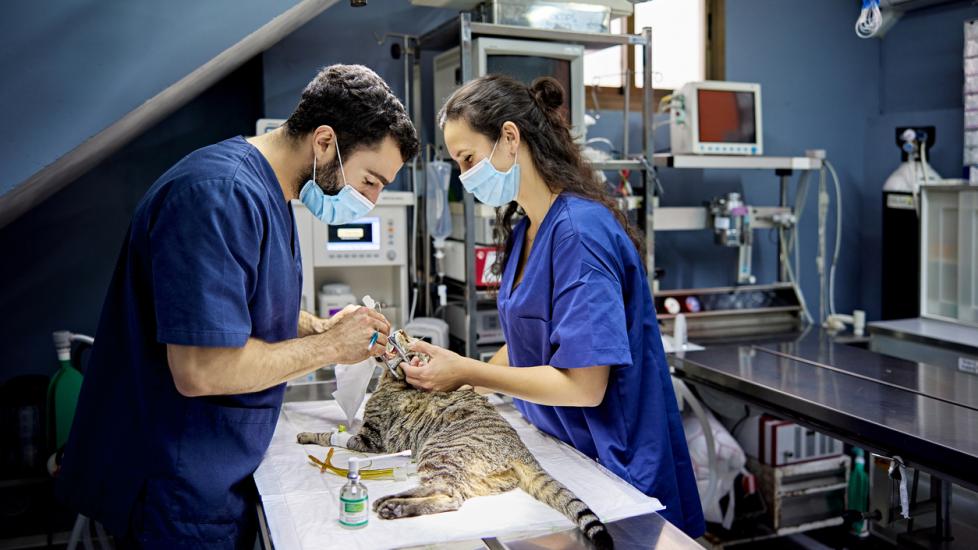Cat Spay 101
The many benefits to spaying your female cat include eliminating the risk of uterine infections, reducing cat overpopulation by stopping pregnancy, lowering the risk of mammary gland cancer, and decreasing frustrating behaviors during heat cycles.
If you’re considering having your cat spayed, here’s some helpful info on the procedures, cost, best timing, aftercare, and changes you can expect after your cat is spayed.
What Is Cat Spaying?
A spay, or ovariohysterectomy, is a procedure that eliminates the possibility of pregnancy. Spaying removes the cat’s ovaries and uterus and prevents estrus (heat cycles) and possible uterine infections in the future.
This procedure is the female sterilization version of neutering. Neutering is performed in male cats by removing the testicles to eliminate sex organs/hormones and possible impregnation of female cats.
Vet Recommended Health Support
- Douxo S3 CALM Soothing Itchy, Hydrated Skin Dog & Cat Mousse, 5.1-fl oz bottle$28.69Chewy Price
- Purina Pro Plan Veterinary Diets FortiFlora Powder Probiotic Digestive Supplement for Cats, 30 count$30.99Chewy Price
- Purina Pro Plan Veterinary Diets Hydra Care Liver Flavored Liquid Supplement for Cats, 3-oz pouch, case of 12$14.99Chewy Price
- Purina Pro Plan Adult Sensitive Skin & Stomach Lamb & Rice Formula Dry Cat Food, 7-lb bag$28.08Chewy Price
What’s the Cost for Spaying a Cat?
Cat spays range in price and depend on the location where the surgery is performed. Spays performed at local spay and neuter clinics are usually the most cost-effective, with prices ranging from $100–$300. Prices for spays performed at primary care veterinarians (your general practice clinic) usually range from $300–$800.
Prices may increase based on age, if your cat is in heat, or has a uterine infection (pyometra), as these cats are higher risk and the procedure is more difficult due to enlarged blood vessels and/or systemic illness. Costs of spays performed by a board-certified surgeon or at emergency hospitals can range from $2,000–$4,000 depending on the stability of the cat’s health, age, pre-operative blood work findings and how long hospitalization is necessary.
Most rescues and humane societies perform spays before a cat even gets adopted, which eliminates this hefty cost to the new pet parent. If the kitten is too young for the spay to be safely performed, these facilities often will offer a certificate or receipt that honors a spay in the future at no additional cost to the pet parent.
When to Spay a Cat
Factors that need to be taken into consideration when spaying a cat include the pet’s overall health and age. Cats can be impregnated as young as 4 months old, and some veterinarians and rescues/shelters will perform spays at this age. The average age for spaying a cat is 5-6 months, though they can begin to ovulate (release eggs from the ovaries) earlier than this. Female cats generally have two or three heats per year during their breeding season, which is usually February to October.
It is best to spay a cat when she is not in heat, as this causes blood vessels feeding blood supply to the reproductive system to enlarge. Spays can be performed during heat cycles, but the risk of bleeding and infection increases due to these engorged blood vessels. Unfortunately, since female cats can go into heat frequently during breeding season, sometimes spaying during heat cannot be avoided.
Female cats recently rescued or found outdoors should be assessed for a spay scar, which is usually located just below their belly button (umbilicus). These scars can be quite small, so if you are unsure if there is a spay scar, evaluation by a veterinarian and/or discussion about hormonal testing can be considered.
How a Cat Is Spayed
There are two surgical options for spaying a cat: ovariohysterectomy and ovariectomy. In both instances, general anesthesia using pre-medications (such as buprenorphine and midazolam), induction agents (propofol or alfaxalone), and gas anesthetic (isofluorane or sevofluorane) will be given.
The surgical procedures range from 15 minutes to 1 hour depending on the size of the patient, the size of the uterus, and the skill of the surgeon. The entire length of pre-operative procedures and recovery from anesthesia is usually 2-3 hours.
Either procedure can be completed with laparoscopy. This method uses an endoscope, a thin tube with a light and camera to help the vet see inside your cat. Vets who can do laparoscopic surgeries have gotten extra training in this technique.
Some veterinarians will recommend hospitalization overnight for monitoring, pain control, and fluid therapy, even in routine spays.
Ovariohysterectomy
An ovariohysterectomy is the spaying procedure most often used. This surgery removes the cat’s uterus and ovaries.
To do the ovariohysterectomy, the vet will shave an area on the underside of your cat’s belly. Removing the hair lowers the risk of infection. Then, the vet will make an incision (cut) in the shaved area and remove the entire reproductive tract. This includes the ovaries, uterus, and the area where the uterus and fallopian tubes connect (uterine horns).
Ovariectomy
The less common procedure is an ovariectomy, which only removes the cat’s ovaries, leaving the uterus intact. For this surgery, the incision can be made on the underside of your cat’s stomach or on her flank (the side of her stomach). Leaving the uterus means that there is still a chance your cat could get uterine cancer later in life.
Aftercare for Cat Spaying
A spay procedure is abdominal surgery (the abdomen is opened for surgery to be performed) and requires restful downtime and close monitoring after completion. The incision takes about 10-14 days to heal. An Elizabethan collar (cone) is usually sent home with you to avoid licking the incision, which can cause infection, swelling, pain or even worse, can open the incision site.
Strict rest is recommended until the recheck examination in 10-14 days. This means confinement to a crate or a small room to lessen movement that could pull open the incision. Pulling at the edges of the incision can lead to incisional breakdown, infection, fluid formation under the skin, and pain.Your veterinarian will ask you to closely monitor the incision daily and to report any concerns.
Female Cat Behavior After Spaying
Changes in your cat’s behavior will be minimal after spaying. This procedure can eliminate annoying mating behaviors such as vocalization, rubbing the hind end all over the house and you, or trying to escape outside. Thankfully, your cat’s overall behavior will likely stay the same. Spaying does reduce sex hormones, which can make your cat seem calmer overall after the procedure, but most veterinarians believe that is due to eliminating mating behaviors.
Do Spayed Cats Gain Weight?
Slight to moderate weight gain can also occur after spaying due to the decrease in sex hormones.These sex hormones help to maintain metabolism, and as they decrease following a spay, so does the metabolism.
It is necessary to monitor your cat’s body weight for several years after spaying to avoid obesity, which can lead to issues such as joint disease and diabetes. It is also important to discuss exercise and caloric requirements for your cat prior to and after a spay procedure.
Featured Image: iStock.com/xavierarnau




